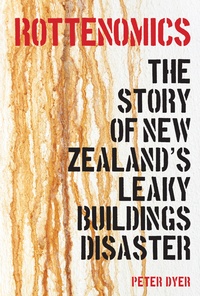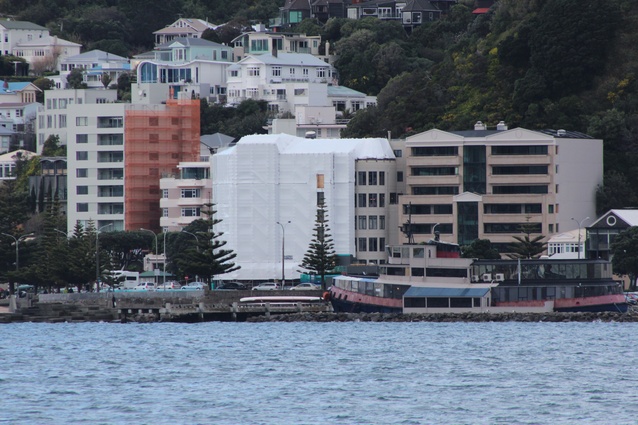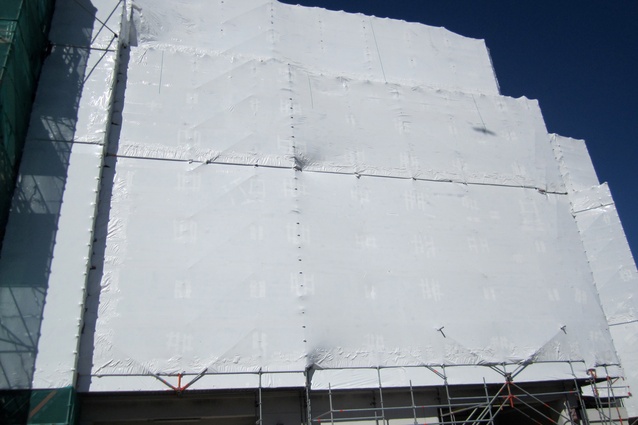Review: Rottenomics: The Story of New Zealand’s Leaky Buildings Disaster
John Sutherland considers Peter Dyer’s comprehensive investigation into one of the country’s most costly human-made disasters – New Zealand’s leaky building syndrome.
Peter Dyer examines everything he believes caused ‘the perfect storm’ that led to New Zealand’s ‘leaky building syndrome’, arguing it can be largely sheeted home to “Rogernomics” and the new political belief in the effectiveness of market forces.

Before I start, let me declare some inside knowledge. I was a member of the Buildings Research Industry Group (BRIG) and a protagonist for change, based on Professor Helen Tippett’s research and a belief in the value of a performance-based code for the future of a mature industry. I joined the interim Building Industry Authority (BIA) in September 1990, to help turn the Building Industry Commission’s (BIC) work into reality. I can confirm (supported by BIA chairperson, Wyn Hoadley) that the BIA was never instructed by the Lange cabinet that a ‘free market’ philosophy of ‘light-handed regulation’ should prevail.
I went through to the real BIA in 1992, by which time the government had changed and Jim Bolger was PM. We had a new Chairman and, apart from two of us, new membership. From that time, attitudes did change.
Dyer has picked up that the 1994 BIA Annual Report confirms that its mission “includes the continual review and removal, where possible, of bureaucratic constraints and the reduction of costs”. This is the recipe for disaster he is looking for. He gets it very right about the awful effect of the ‘dead hand of the market’ (and politics) on technical building regulations.
One reason why leaky building syndrome is such a difficult issue to understand is its multi-faceted nature, which militates against finding the simple solution everyone seems to want. Dyer’s list and discussion includes:
• The selection of building timbers. By 1990, the choice for building framing was almost exclusively pinus radiata softwood from depression-era planted forests – timber that needed treatment to prevent mould and rot when wetted above 18 per cent. Excluding water getting anywhere near this timber became vital once the timber companies lobbied successfully for no treatment and Standards Association
of New Zealand (SANZ) caved in and made the necessary alterations and NZS 3602: 1995 to allow this.
• The use of monolithic type faced-fixed claddings. These should have been considered as “Alternative Solutions” in the code and subjected to more scrutiny. It was a time when all claddings, except brick and one form of stucco, were face-fixed over building paper anyway. Cavities to drain water away generally became required building practice in 2005 for most claddings governed by E2/AS1 Table 3.
• Inadequate numbers in the workforce. There was a general loss of skills and knowledge at all levels, including those on the tools, QA supervisory staff, roaming project managers and designers. This is a regularly occurring New Zealand problem.
• Underfunding. This undoubtedly affected the BIA in all respects, especially its education programmes.
• Observation of work put in place. The key question was: Who should do this? The Building Act (BA91) said, as part of “plans and specifications”, it must happen and the application forms for building consent contained space to record who would do that. The obvious candidates were the original designers, building inspectors and the new private certifiers. Often the space on the form was never filled in at all.
• Joint and several liability. In the courts, this is referred to as ‘last man standing’ rules and relates to the application of normal liquidation and bankruptcy business practices to construction. These rules have not changed.
• The NZS 1900:1964 Model Building Bylaw. This system was every bit as broken and chaotic as Professor Tippett’s research showed. But what should replace it? Dyer seems to be saying these bylaws shouldn’t have been changed and certainly not by a performance-based building code.
Dyer has wrestled, with great energy, with all the above. But, seriously missing from this list is a basic understanding of New Zealand culture and attitude towards regulations of any kind. This would have led him to understanding that the essence of innovation is disruption and radical change with a need for a big, very clear “what’s in it for me” factor for all those affected. In this case, a whole building industry must agree to change their behaviours, business practices and responsibilities. In short, there has to be a benefit (probably financial) to buying in. I don’t think Dyer understands this. He doesn’t discuss it.
The issues of disruption and change can be related to the necessity of a ‘top-down’ introduction of a performance-based BA91 to replace the age-old and creaking model of compliance: NZS 1900: 1964 Model Building Bylaw. It was a prescriptive bylaw requiring statements in considerable detail on how to comply on a product-by-product basis. BA91 is performance-based. It states only the outcomes required: that is, how a product/system must meet those outcomes set against a series of stringent statements or metrics. The BIC thought this was a much better type of code and would be able to cope with the greater number of products expected with more accuracy and less delay. But, new products that fell into the Alternative Solution category might take longer to get to market because of the rigorous processes of a BRANZ Appraisal or a full BIA Accreditation – which, although slow, is also a ‘good thing’ in the longer term.
I agree with Dyer that this did not always happen in the confusion of what, in 1992, constituted an Alternative Solution at local body level. But how that can be described as ‘light-handed regulation’ is difficult to understand and Dyer does not explain. He spends considerable time elevating the topic of “who thought that a performance-based code was a good idea” into a conspiracy by elites.
This is where I think he has it wrong. He believes a group of senior industry people must have acted either on a basis of “faith”, ill-considered research or instructions from the Lange government, or all three, rather than engaging in a proper study and due consideration of alternatives. He declares that only the UK was running a performance-based code (since 1984) at the time, ignoring the fact that BRIG and then BIC knew of and studied a seven-level, Nordic performance-based code dating back to 1978 and operational in the three Scandinavian countries. BA91 covers the same ground in three levels: an Act, a Code and Compliance documents.
Dyer spends much time looking for villains and comes up with the governments, generally, and Treasury, in particular, because, surprisingly, it had encouraged PM Robert Muldoon to support the investigations. Then, within the Rogernomics period, Treasury approved, funded and encouraged the establishment of the BIC, while failing utterly to provide the financial resources necessary for the success thereafter of the BIA.
It is an open question if pre-1991 face-fixed claddings on building paper did leak, (weatherboards were known generally not to) but in the market at the time were at least two monolithic products that the industry did not know how to assemble properly and did let water through their basically jointless façades.
By 1994, even before the code allowed untreated timber, the rot had set in. This is the essence of Dyer’s ‘perfect storm’. Other issues were disasters waiting to happen and Dyer deals very thoroughly and probably unarguably with all of these collateral issues mentioned earlier.
No one involved anticipated an easy ride for a New Zealand variant of a performance-based code for several reasons. One was the obvious lack of resources. But, this is our way. At the time, the choice of a performance-based code was not a mistake but a necessity and of itself need not have caused Dyer’s “perfect storm”. Despite my arguments against his conspiracy theories, I can recommend this book as a great cautionary tale of a disaster which should not have happened and which Dyer and some others maintain is still on-going.
It is true that the basic technical issues which caused the failures have been recognised and, in E2/AS1: 2005, attended to by forcing the use of a 19mm drained and ventilated cavity external to structure based on the Canadian-devised 4Ds. This suggests four key elements for managing water on walls: deflection and drainage of the cavity; drying the cavity by ventilation; and durability of suitable materials. E2/AS1 has become the ‘how to build’ textbook for housing relied upon by the BCA for building consents but, too often, referred to as ‘the code’. Timber treatment has been sensibly reformed around H3.1 treatment for basic timber framing. All of these are ‘good’ but leave untouched many of the collateral issues that Dyer lists on p64 as having contributed to the ‘leaky buildings syndrome’ in the first place. Responsibility for the latest Building Act (BA04) has disappeared into MBIE and its attempt to control the quality of incoming new materials at arm’s-length via CodeMark would appear to have collapsed, which is a very serious problem.
So, perhaps Dyer is right. We are still very wedded to allowing market forces to drive an entrepreneurial industry.

We received a few responses to the above review after it was first published in the May/June 2020 issue of Architecture NZ. See the letters to the editor below:
Letter to the editor, from the author, Peter Dyer
I’d like to publicly thank Mr Sutherland for the many hours, documents and the invaluable personal and historical perspective he graciously provided me in this project. It was truly a privilege to work with him. I appreciate, as well, the time and trouble he took to read and review Rottenomics. I’m gratified he found value in the book and that his review was generally favourable.
There are a few points in his review I’d like to address.
Building Act 1991 brought in a brand-new national, unified set of performance-based building controls. The old, chaotic collection of prescriptive controls based on NZS 1900:1964 was gone. In his review, Mr Sutherland wrote, “Dyer seems to be saying these bylaws shouldn’t have been changed…”
This was not my perspective. Rather, I suggested things might have turned out better had the early direction set by architect Helen Tippett’s research been maintained. This was essentially, as I wrote, “keep the good bits, while fixing the rest.”
Mr Sutherland mentioned the confusion surrounding BRANZ appraisals, BIA accreditation and Alternative Solutions. In so doing, he ascribes the words “light-handed regulation” to me. But these words are not mine. This phrase appears twice in the book, first in a quotation from Brian Easton, and then in a selection from the Hunn Report.
Mr Sutherland believes I “…spend considerable time elevating the topic of ‘who thought a performance-based code was a good idea’ into a conspiracy by elites.”
The words “conspiracy” and “conspire” do not appear in Rottenomics. They imply covert, behind-the scenes discussion and decision-making.
It does seem clear that the two-volume (1983–1984) Review of Planning and Building Controls that helped lay the groundwork for the Building Industry Commission Report and for Building Act 1991 was based in incomplete research and ended in pre-ordained conclusions.
However, there seems little that was covert about the Review. The research and reports appear to have been accessible, throughly recorded and above-board. It never occurred to me to imply otherwise.
Mr Sutherland later writes, “[Dyer] declares that only the UK was running a performance-based code (since 1984) at the time, ignoring the fact that BRIG and the BIC knew of and studied a seven-level Nordic performance-based code dating back to 1978 and operational in three Scandinavian countries.”
To clarify: I wrote that, at the time of the Review, there was no data available on the performance of performance-based building codes. Only one such code existed. That was in UK. This had only recently come on line and would not be fully operational for another eight years.
My source was Brian Meacham’s “Performance-based Building Regulatory Systems: principles and experiences”, published in 2010. According to Meacham, performance codes were introduced in Norway in 1985 and in Sweden in 1988. If so, no data would have been available in 1984.
Meacham did write that Denmark included the “first performance compliance option” in their building code in 1982. However, this code was not overall performance-based until 2005.
If Meacham was mistaken and the Nordic codes did precede the Review then, of course, my statement was incorrect. If so, I apologise.
– Peter Dyer
Letter to the editor, from the reviewer, John Sutherland
With regard to Peter Dyer’s response to my review:
1. The two-volume (1983–1984) Review of Planning and Building Controls researched and written by Searle and Scoular was not ‘pre-ordained’. But it was seen by BRIG as very helpful to the cause of reform and, in that it served to convince PM Muldoon that there was work to be done, it was seminal. Lange’s Internal Affairs minister then set up the Building Industry Commission to do further work which would lead to BA91.
2. Dyer writes he “suggested things might have turned out better had the early direction set by architect Helen Tippett’s research been maintained.” He thought Tippett meant “keep the good bits, while fixing the rest”. If she ever thought that, she must have changed her mind when she joined the BIC, where her involvement showed she was an enthusiast for performance-based building controls.
3. But, in any case, the “good bits” were moving inexorably towards a performance code. Even SANZ, guided by E H Hitchcock, had been moving in that direction. His 1979 paper “Technological Law and…” came down firmly in its favour and BRANZ Conference Paper #10 “Innovation and Building Controls” covered off all this ground in February 1985.
– John Sutherland
Letter to the editor, from Don Bunting, FNZIA
I read with interest John Sutherland’s thoughtful and detailed review of Peter Dyer’s book on the leaky buildings issue. My own involvement with the BIA, Standards NZ and latterly MBIE overlapped with John’s as we all struggled to make sense of how the industry could have got it so wrong; when the move to a performance-based building code was done with the best of advice and the best of intentions.
As Chair of three key Standards committees in the 2000s – on timber treatment, timber strength and finally NZS3604:2011 Timber-Framed Buildings – I witnessed the struggle to regain control over an industry that had gone feral. NZS 3602:2003 Timber Treatment recovered the ground lost when the industry was seduced by the two main radiata pine suppliers’ belief that untreated framing would not rot if it remained dry. The weakness of this argument was revealed when the last four words in that belief statement – if it remained dry – proved to be an illusion. Accept face sealed cladding systems as compliant and then add what might be described as a “Mediterranean” approach to a building’s appearance – complete with in-line decks – and failures were inevitable. Water got in and couldn’t get out.
The amendment to NZS 3603:1993 Timber Strength and its associated chemical treatment Standard NZS 3640:2003 removed the influence of the main timber suppliers in reflecting the real strength of the radiata pine coming out of our forests and the reintroduced chemical treatment rules. The work on NZS 3604:2011 included a much needed review of all content but, more importantly, ensured that there was clarity and consistency between the timber framed building standard and the rewriting and expansion of the acceptable solution E2/AS1.
I worked with John Sutherland during that period and relied on his deep knowledge of the science of building envelope design. John’s review of Peter Dyer’s book is well put, both in where he accepts and where he disagrees with the book’s arguments and any placing of blame. From my own involvement in this less than stellar period, I agree that there was no “conspiracy by elites.” It was, howeve,r a wakeup call for the industry; accepting that not only is New Zealand’s climate both wet and windy but, by moving away from 1970’s timber weatherboards on boric treated pine framing to more exotic cladding forms, we needed a more scientific approach.
What, in my view, is missing both from the book and from John Sutherland’s review are three key issues.
The first is a failure of our industry to establish a clear pathway for branded materials and products to establish compliance, either with the Building Code Statements or the associated compliance documents – the acceptable solutions and verification methods. Whether this should be the ability to gain approval for manufacturers’ own branded acceptable solutions, or the establishment of a national database of compliant products, or both, I leave to others.
I tried my best to establish the latter with Masterspec’s miproducts database and the product technical statements it contains. The former was intended to be met by MBIE’s CodeMark system but this has failed to gain any traction. In its stead, there appears to be far too much reliance placed on BRANZ Appraisals, for want of something more specifically designed to prove compliance.
The second issue concerns the decision to give even partial autonomy to council-based Building Consent Authorities. Bluntly, the available talent pool was, and to some extent still is, stretched too thin. Highly trained building technologists, architects and engineers are unlikely to see this career path as attractive. A single, well-resourced national Building Consent Authority, containing highly qualified and committed staff and with full control over the standards and processes of its branch BCAs, was and still is sorely needed. This would also allow the introduction of an effective initial digital vetting process for all project documents at national level, before documents are passed on to branch BCAs. The current cost and time frame for building consents is scandalous.
The last issue concerns a failure by the industry to seriously address the issue of responsibility and liability. The Building Act does little more than touch on this critical issue. Set aside legal issues for the moment, which are usually based on a “last man standing” approach. Look instead at a fatal flaw; the lack of adequate oversight during the construction and sign-off phase. Imagine if the designer, be it architect, engineer, draughtsperson, or design-builder, was legally responsible for compliance. If that were the case, there would always be full involvement by the designer in the construction phase. Instead, the designer was and is often sent packing once a building consent is obtained, leaving the sole independent oversight being the occasional visit by a council inspector. This concern remains with us today, the results shielded by those white plastic tents dotting the construction landscape.
– Don Bunting
Letter to the editor, from Dr David Gatley, ANZIA
The purpose of this article is to review some of the comments made by John Sutherland in his analysis of Peter Dyer’s book ‘Rottenomics’. I admit to not having read Mr Dyer’s book but I am certain that Mr Dyer will most likely be unaware of the matters that I am commenting upon whereas John probably is.
Firstly, John comments that ‘the selection of untreated building timbers’ was allowed by SANZ following successful lobbying by timber companies. What John has omitted to advise was that the ‘lobbying’ was made necessary following the introduction in the early 1990s of the Resource Management Act and that, prior to the introduction of the Act, timber companies could dispose of the toxic waste material from the tanalising process, viz., Copper Chrome Arsenate [CCA] in any way how they wished. The RMA changed that.
The RMA was used very effectively by environmental groups to make the treatment of building timbers an impossible task. While the timber companies lobbied using the argument that untreated pinus radiata was widely used following WW2, they failed to advise that the post-war timber was grown, seasoned, and used very differently than the 1990s version of this material. Building methods and other materials, such as claddings, flashings and sealants, had also changed dramatically. It should also be noted that ALL of the various political parties supported this change.
The second matter that I wish to comment upon is the role of the Building Industry Authority [BIA] and their responsibility in the ‘leaky building’ debacle. During the mid-1990s, when John was Head of the School of Architecture at Unitec and I was a Senior Staff Member lecturing in Construction Law, we had numerous discussions during our over 20-year collaboration about the role of ‘Independent building certifiers’. Surprisingly, John does not refer to such persons in his review and the role that they played. I can remember during one conversation with John when expressing his support for having ‘independent certifiers’ saying that he found it incongruous that a Council Building Inspector could have inspected a residential building in the morning and then the same Inspector, visiting and inspecting a large commercial building in the afternoon.
John identified a particular commercial building that he was involved with at the time that would benefit from having an Independent Building Certifier but I think it inappropriate for me to identify this project. I agreed that, as it was more than likely that the Architect, Engineer and etc., would be engaged by the client to administer the contract during the execution of the works on this large commercial project and therefore, the involvement of Council Building Inspectors would, by and large, be superfluous. However, I strongly disagreed then, as I do now, that the Architect [or designer] is very rarely involved with this stage of the project on residential and some smaller commercial projects. The non-involvement of such has, in a large part, resulted in ‘leaky buildings’. I have seen many projects where the builder and/or client have changed the original specification and details, without reference to the Architect, which have resulted in failures.
My PhD thesis titled: ‘A critical examination of building contract in New Zealand’, completed in 2004, provided substantial empirical evidence to support a ‘Principle of Remotivity’ which states that:
‘the further the architect (or designer) is from the independent administration of a contract acting in a quasi-judicial capacity as anticipated by the Courts, the more likely it is that disputes will arise during the execution of the contract’.
Many fellow architects have in recent years, for whatever reasons, decided to avoid being involved in the administration of the contract during construction and, in doing so, have been derelict in their duty. This is not just my view but one that is supported by the legal system. An analysis of many of the ‘leaky building’ claims will show that the Architect [or designer] to have been determined to be negligent even when they were not contractually engaged to administer the contract during the construction phase.
In 2003, I and six others were appointed as Adjudicators by the Governor General under the Weathertight Homes Resolution Services Act 2002 to hear and determine ‘leaky building’ claims. The first cases were heard by two Adjudicators. I heard my first case with fellow Adjudicator, David Carden during and towards the end of 2003. The case of Putman v. Ors can be reviewed in the Department of Building and Housing website. Case no. 00026.
One of the parties who had been joined in the claim was Approved Building Certifiers Limited [ABC] who been engaged by the builder of a house in Pakuranga, Auckland to inspect and certify that the building complied with the Building Code. They were represented by Mr Neil Boler, a Director of ABC.
During the hearing, the representative of ABC advised that:
‘Approved Building Certifiers Limited’s insurance policy does not respond to this claim’. [Refer to clause 7.23 on page 38 of the Determination].
It is worth quoting what David Carden and I concluded in clause 7.23 of the Determination as follows:
‘Apart from having difficulty understanding exactly what that means, we note that it was a requirement of approval of the building certifier by the Building Industry Authority pursuant to s51 that the application should include evidence that a scheme of insurance approved by the authority would apply in respect of any insurable civil liability that might arise out of the issue of a Code Compliance or Building Certificate. The requirement for insurance came to our attention at the first preliminary conference we had when Mr Boler made some reference to the possible lack of liquidity on the apart of Approved Building Certifiers Limited (refer Direction no 3 dated 15 July 2003 at paragraph 5). Nothing was addressed to us on the reason why any scheme of insurance that ABC may have had to satisfy the requirement of s51(3) was not sufficient to cover it in respect of any liability it may have in this matter. That is outside the scope of inquiry but it seems that the policy behind the Act is avoided if the very liability that we have found against the building certifier is not covered by appropriate insurance despite the requirement of s51 for that to be the case’.
ABC were found to have been negligent and were ordered to pay the claimants $107,000.
Following this case [and others], the Adjudicators were of the view that the BIA had acted negligently by not requiring evidence of appropriate insurance when approving the application or annual renewal of a Building Certifier. This was certainly the case with ABC. The Adjudicators concluded that, in future cases, any applications for including the BIA a liable party to the claim would be favourably considered.
Not long after that decision was made, word came down from the highest levels of Government advising that if the BIA were joined that: ‘there would be consequences and that to join the BIA as a party to these claims would cost the NZ taxpayer tens of billions of dollars’.
Well there were consequences. Shortly after we confirmed our intention to join the BIA, the WHRS Act of 2002 was repealed; the six original Adjudicators were removed from office; a new 2006 Act was introduced to Parliament; and a new panel of Adjudicators were appointed. I did not see any of the above included in John’s analysis of ‘what happened [or in fact, did not and should have happened] at the BIA’. However, I have laid out the facts as I know them to be for the reader to make their own minds up on whether the BIA were negligent or not.
Finally. On the day that my copy of the May/June 2020 edition of Architecture NZ arrived, the Government announced that certain small buildings could be constructed by DIY builders without having to apply for and be granted a building consent. Following the release of this announcement, the consistent comment that I am hearing from just about everywhere is: ‘here we go again’. My advice to Government is that while their intentions may be honourable, this is a hair-brained scheme that will undoubtedly, end in tears.
My daughter and son-in-law have just spent nearly 2 years and over $40,000 in professional, council and other fees to get a resource and building consent for an out-building on their property. I don’t think that a downturn in our economy as a consequence of a global pandemic warrants what the Government is proposing. The damage experienced down the track will be even more devastating than anything we have encountered so far. Remember the ‘Cave Creek’ viewing deck and the owner-built carport adjacent to a school in South Auckland that collapsed. Just two failures that come to mind. The construction industry in New Zealand is far from being in a good state.
– Dr David Gatley
PhD, M.Des.Mgmt, DipArchTech, ANZIA, Registered Architect














